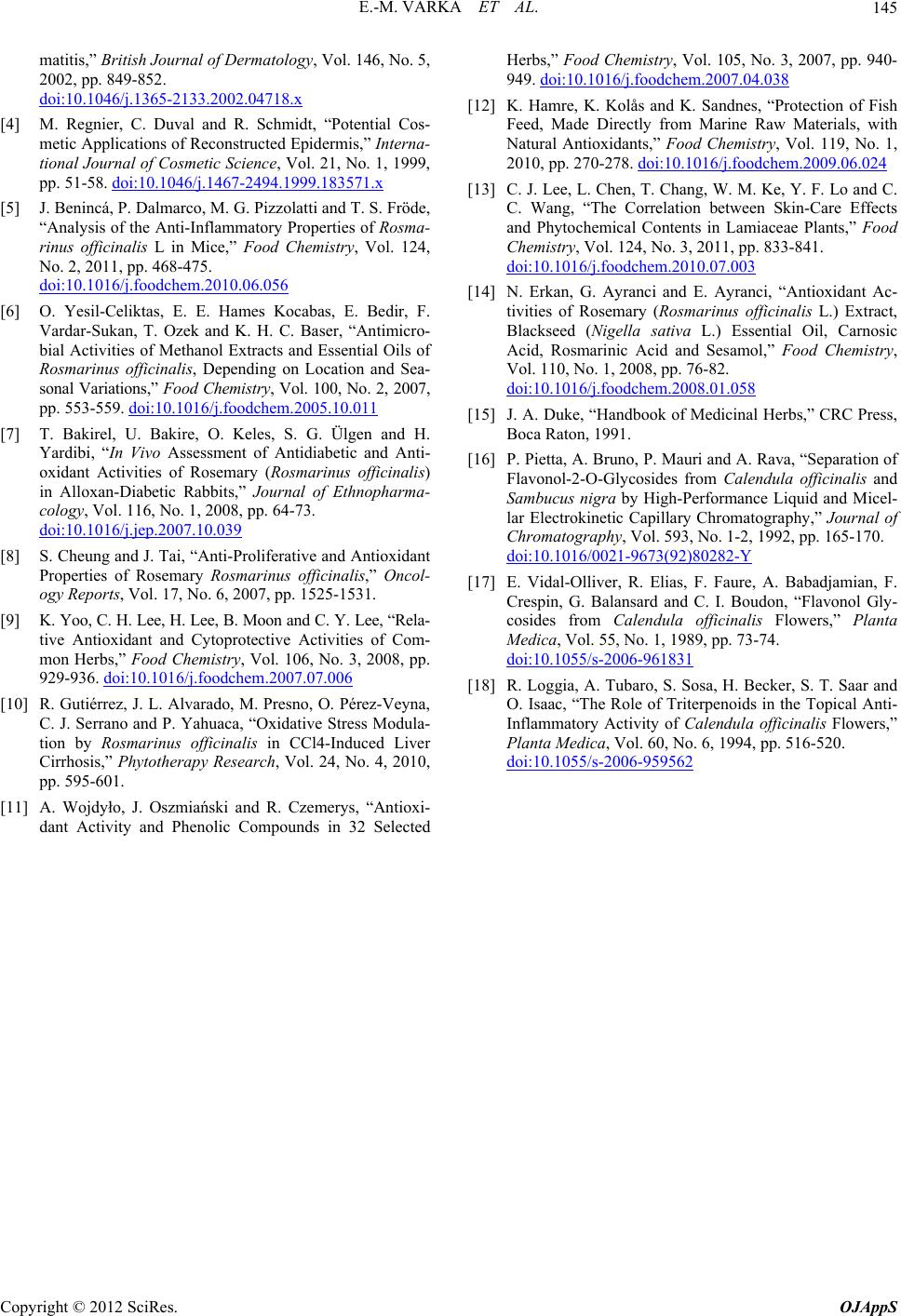
E.-M. VARKA ET AL.
Copyright © 2012 SciRes. OJAppS
145
matitis,” British Journal of Dermatology, Vol. 146, No. 5,
2002, pp. 849-852.
doi:10.1046/j.1365-2133.2002.04718.x
[4] M. Regnier, C. Duval and R. Schmidt, “Potential Cos-
metic Applications of Reconstructed Epidermis,” Interna-
tional Journal of Cosmetic Science, Vol. 21, No. 1, 1999,
pp. 51-58. doi:10.1046/j.1467-2494.1999.183571.x
[5] J. Benincá, P. Dalmarco, M. G. Pizzolatti and T. S. Fröde,
“Analysis of the Anti-Inflammatory Properties of Rosma-
rinus officinalis L in Mice,” Food Chemistry, Vol. 124,
No. 2, 2011, pp. 468-475.
doi:10.1016/j.foodchem.2010.06.056
[6] O. Yesil-Celiktas, E. E. Hames Kocabas, E. Bedir, F.
Vardar-Sukan, T. Ozek and K. H. C. Baser, “Antimicro-
bial Activities of Methanol Extracts and Essential Oils of
Rosmarinus officinalis, Depending on Location and Sea-
sonal Variations,” Food Chemistry, Vol. 100, No. 2, 2007,
pp. 553-559. doi:10.1016/j.foodchem.2005.10.011
[7] T. Bakirel, U. Bakire, O. Keles, S. G. Ülgen and H.
Yardibi, “In Vivo Assessment of Antidiabetic and Anti-
oxidant Activities of Rosemary (Rosmarinus officinalis)
in Alloxan-Diabetic Rabbits,” Journal of Ethnopharma-
cology, Vol. 116, No. 1, 2008, pp. 64-73.
doi:10.1016/j.jep.2007.10.039
[8] S. Cheung and J. Tai, “Anti-Proliferative and Antioxidant
Properties of Rosemary Rosmarinus officinalis,” Oncol-
ogy Reports, Vol. 17, No. 6, 2007, pp. 1525-1531.
[9] K. Yoo, C. H. Lee, H. Lee, B. Moon and C. Y. Lee, “Rela-
tive Antioxidant and Cytoprotective Activities of Com-
mon Herbs,” Food Chemistry, Vol. 106, No. 3, 2008, pp.
929-936. doi:10.1016/j.foodchem.2007.07.006
[10] R. Gutiérrez, J. L. Alvarado, M. Presno, O. Pérez-Veyna,
C. J. Serrano and P. Yahuaca, “Oxidative Stress Modula-
tion by Rosmarinus officinalis in CCl4-Induced Liver
Cirrhosis,” Phytotherapy Research, Vol. 24, No. 4, 2010,
pp. 595-601.
[11] A. Wojdyło, J. Oszmiański and R. Czemerys, “Antioxi-
dant Activity and Phenolic Compounds in 32 Selected
Herbs,” Food Chemistry, Vol. 105, No. 3, 2007, pp. 940-
949. doi:10.1016/j.foodchem.2007.04.038
[12] K. Hamre, K. Kolås and K. Sandnes, “Protection of Fish
Feed, Made Directly from Marine Raw Materials, with
Natural Antioxidants,” Food Chemistry, Vol. 119, No. 1,
2010, pp. 270-278. doi:10.1016/j.foodchem.2009.06.024
[13] C. J. Lee, L. Chen, T. Chang, W. M. Ke, Y. F. Lo and C.
C. Wang, “The Correlation between Skin-Care Effects
and Phytochemical Contents in Lamiaceae Plants,” Food
Chemistry, Vol. 124, No. 3, 2011, pp. 833-841.
doi:10.1016/j.foodchem.2010.07.003
[14] N. Erkan, G. Ayranci and E. Ayranci, “Antioxidant Ac-
tivities of Rosemary (Rosmarinus officinalis L.) Extract,
Blackseed (Nigella sativa L.) Essential Oil, Carnosic
Acid, Rosmarinic Acid and Sesamol,” Food Chemistry,
Vol. 110, No. 1, 2008, pp. 76-82.
doi:10.1016/j.foodchem.2008.01.058
[15] J. A. Duke, “Handbook of Medicinal Herbs,” CRC Press,
Boca Raton, 1991.
[16] P. Pietta, A. Bruno, P. Mauri and A. Rava, “Separation of
Flavonol-2-O-Glycosides from Calendula officinalis and
Sambucus nigra by High-Performance Liquid and Micel-
lar Electrokinetic Capillary Chromatography,” Journal of
Chromatography, Vol. 593, No. 1-2, 1992, pp. 165-170.
doi:10.1016/0021-9673(92)80282-Y
[17] E. Vidal-Olliver, R. Elias, F. Faure, A. Babadjamian, F.
Crespin, G. Balansard and C. I. Boudon, “Flavonol Gly-
cosides from Calendula officinalis Flowers,” Planta
Medica, Vol. 55, No. 1, 1989, pp. 73-74.
doi:10.1055/s-2006-961831
[18] R. Loggia, A. Tubaro, S. Sosa, H. Becker, S. T. Saar and
O. Isaac, “The Role of Triterpenoids in the Topical Anti-
Inflammatory Activity of Calendula officinalis Flowers,”
Planta Medica, Vol. 60, No. 6, 1994, pp. 516-520.
doi:10.1055/s-2006-959562